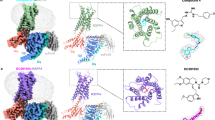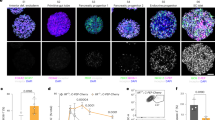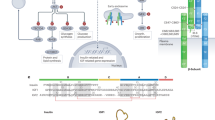Abstract
Insulin, IGF, and relaxin are established members of the insulin protein superfamily. The application of the techniques of cellular, molecular, and computational biology has permitted the identification of new insulin-like ligands and their cognate receptors. Information regarding the biologic role is available for some of these newly identified ligand-receptor systems and indicates novel roles in diverse processes such as testicular descent, germ cell function, and cell migration.
Similar content being viewed by others
Log in or create a free account to read this content
Gain free access to this article, as well as selected content from this journal and more on nature.com
or
Abbreviations
- GPCR:
-
G protein-coupled receptor
- GREAT:
-
G protein-coupled receptor affecting testis descent
- INSL:
-
insulin-like protein
- LGR:
-
leucine-rich repeat-containing G protein-coupled receptor
References
Le Roith D, Shiloach J, Roth J, Lesniak MA 1980 Evolutionary origins of vertebrate hormones: substances similar to mammalian insulins are native to unicellular eukaryotes. Proc Natl Acad Sci U S A 77: 6184–6188
Konopinska D, Rosinski G, Sobotka W 1992 Insect peptide hormones, an overview of the present literature. Int J Pept Protein Res 39: 1–11
Smit AB, van Marle A, van Elk R, Bogerd J, van Heerikhuizen H, Geraerts WP 1993 Evolutionary conservation of the insulin gene structure in invertebrates: cloning of the gene encoding molluscan insulin-related peptide III from Lymnaea stagnalis. J Mol Endocrinol 11: 103–113
Ishizaki H, Suzuki A 1994 The brain secretory peptides that control moulting and metamorphosis of the silkmoth, Bombyx mori. Int J Dev Bil 38: 301–310
Duret L, Guex N, Peitsch MC, Bairoch A 1998 New insulin-like proteins with atypical disulfide bond pattern characterized in Caenorhabditis elegans by comparative sequence analysis and homology modeling. Genome Res 8: 348–353
Reinecke M, Eppler E, David I, Georges D 1999 Immunohistochemical evidence for the presence, localization and partial coexistence of insulin, insulin-like growth factor I and relaxin in the protochordate Ciona intestinalis. Cell Tissue Res 295: 331–338
Blundell TL, Humbel RE 1980 Hormone families: pancreatic hormones and homologous growth factors. Nature 287: 781–787
Burkhardt E, Adham IM, Brosig B, Gastmann A, Mattei MG, Engel W 1994 Structural organization of the porcine and human genes coding for a Leydig cell-specific insulin-like peptide (LEY I-L) and chromosomal localization of the human gene (INSL3). Genomics 20: 13–19
Zimmermann S, Steding G, Emmen JM, Brinkmann AO, Nayernia K, Holstein AF, Engel W, Adham IM 1999 Targeted disruption of the Insl3 gene causes bilateral cryptorchidism. Mol Endocrinol 13: 681–691
Chassin D, Laurent A, Janneau JL, Berger R, Bellet D 1995 Cloning of a new member of the Insulin gene superfamily (INSL4) expressed in human placenta. Genomics 29: 465–470
Koman A, Cazaubon S, Couraud PO, Ullrich A, Strosberg AD 1996 Molecular characterization and in vitro biological activity of placentin, a new member of the insulin gene family. J Biol Chem 271: 20238–20241
Conklin D, Lofton-Day CE, Haldeman BA, Ching A, Whitmore TE, Lok S, Jaspers S 1999 Identification of INSL5, a new member of the insulin superfamily. Genomics 60: 50–56
Hsu SY 1999 Cloning of two novel mammalian paralogs of relaxin/insulin family proteins and their expression in testis and kidney. Mol Endocrinol 13: 2163–2174
Kasik J, Muglia L, Stephan DA, Menon RK 2000 Identification, chromosomal mapping, and partial characterization of mouse Insl6: a new member of the insulin family. Endocrinology 141: 458–461
Lok S, Johnston DS, Conklin D, Lofton-Day CE, Adams RL, Jelmberg AC, Whitmore TE, Schrader S, Griswold MD, Jaspers SR 2000 Identification of INSL6, a new member of the insulin family that is expressed in the testis of the human and rat. Biol Reprod 62: 1593–1599
Bathgate RA, Samuel CS, Burazin TC, Layfield S, Claasz AA, Reytomas IG, Dawson NF, Zhao C, Bond C, Summers RJ, Parry LJ, Wade JD, Tregear GW 2002 Human relaxin gene 3 (H3) and the equivalent mouse relaxin (M3) gene. Novel members of the relaxin peptide family. J Biol Chem 277: 1148–1157
Kasik JW, Lu C, Menon RK 2000 The expanding insulin family: structural, genomic, and functional considerations. Pediatr Diabetes 1: 169–177
Kumagai J, Hsu SY, Matsumi H, Roh JS, Fu P, Wade JD, Bathgate RA, Hsueh AJ 2002 INSL3/Leydig insulin-like peptide activates the LGR8 receptor important in testis descent. J Biol Chem 277: 31283–31286
Adham I, Burkhardt E, Benahmed M, Engel W 1993 Cloning of a cDNA for a novel insulin-like peptide of the testicular Leydig cells. J Biol Chem 268: 26668–26672
Zimmermann S, Schottler P, Engel W, Adham IM 1997 Mouse Leydig insulin-like (Ley I-L) gene: structure and expression during testis and ovary development. Mol Reprod Dev 47: 30–38
Tashima LS, Mazoujian G, Bryant-Greenwood GD 1994 Human relaxins in normal, benign and neoplastic breast tissue. J Mol Endocrinol 12: 351–364
Pusch W, Balvers M, Ivell R 1996 Molecular cloning and expression of the relaxin-like factor from the mouse testis. Endocrinology 137: 3009–3013
Bathgate R, Balvers M, Hunt N, Ivell R 1996 Relaxin-like factor gene is highly expressed in the bovine ovary of the cycle and pregnancy: sequence and messenger ribonucleic acid analysis. Biol Reprod 55: 1452–1457
Balvers M, Spiess AN, Domagalski R, Hunt N, Kilic E, Mukhopadhyay AK, Hanks E, Charlton HM, Ivell R 1998 Relaxin-like factor expression as a marker of differentiation in the mouse testis and ovary. Endocrinology 139: 2960–2970
Spiess AN, Balvers M, Tena-Sempere M, Huhtaniemi I, Parry L, Ivell R 1999 Structure and expression of the rat relaxin-like factor (RLF) gene. Mol Reprod Dev 54: 319–325
Nef S, Parada LF 1999 Cryptorchidism in mice mutant for Insl3. Nat Genet 22: 295–299
Overbeek PA, Gorlov IP, Sutherland RW, Houston JB, Harrison WR, Boettger-Tong HL, Bishop CE, Agoulnik AI 2001 A transgenic insertion causing cryptorchidism in mice. Genesis 30: 26–35
Tomboc M, Lee PA, Mitwally MF, Schneck FX, Bellinger M, Witchel SF 2000 Insulin-like 3/relaxin-like factor gene mutations are associated with cryptorchidism. J Clin Endocrinol Metab 85: 4013–4018
Marin P, Ferlin A, Moro E, Rossi A, Bartoloni L, Rossato M, Foresta C 2001 Novel insulin-like 3 (INSL3) gene mutation associated with human cryptorchidism. Am J Med Genet 103: 348–349
Canto P, Escudero, Soderlund D, Nishimura E, Carranza-Lira S, Gutierrez J, Nava A, Mendez JP 2003 A novel mutation of the insulin-like 3 gene in patients with cryptorchidism. J Hum Genet 48: 86–90
Feng S, Cortessis VK, Hwang A, Hardy B, Koh CJ, Bogatcheva NV, Agoulnik AI 2004 Mutation analysis of INSL3 and GREAT/LGR8 genes in familial cryptorchidism. Urology 64: 1032–1036
Kawamura K, Kumagai J, Sudo S, Chun SY, Pisarska M, Morita H, Toppari J, Fu P, Wade JD, Bathgate RA, Hsueh AJ 2004 Paracrine regulation of mammalian oocyte maturation and male germ cell survival. Proc Natl Acad Sci U S A 101: 7323–7328
Bieche I, Laurent A, Laurendeau I, Duret L, Giovangrandi Y, Frendo JL, Olivi M, Fausser JL, Evain-Brion D, Vidaud M 2003 Placenta-specific INSL4 expression is mediated by a human endogenous retrovirus element. Biol Reprod 68: 1422–1429
Veitia R, Laurent A, Quintana-Murci L, Ottolenghi C, Fellous M, Vidaud M, McElreavey K 1998 The INSL4 gene maps close to WI-5527 at 9p24.1–>p23.3 clustered with two relaxin genes and outside the critical region for the monosomy 9p syndrome. Cytogenet Cell Genet 81: 275–277
Laurent A, Rouillac C, Delezoide AL, Giovangrandi Y, Vekemans M, Bellet D, Abitbol M, Vidaud M 1998 Insulin-like 4 (INSL4) gene expression in human embryonic and trophoblastic tissues. Mol Reprod Dev 51: 123–129
Janneau JL, Maldonado-Estrada J, Tachdjian G, Miran I, Motte N, Saulnier P, Sabourin JC, Cote JF, Simon B, Frydman R, Chaouat G, Bellet D 2002 Transcriptional expression of genes involved in cell invasion and migration by normal and tumoral trophoblast cells. J Clin Endocrinol Metab 87: 5336–5339
Lu C, Walker WH, Weisz OA, Watkins SC, Witchel SF, Sperling MA, Menon RK 2003 Insulin-like peptide 6 (Insl6): cellular and sub-cellular localization and evidence for post-translational modifications. Proceedings of the 85th Annual Meeting of the Endocrine Society, Philadelphia, PA, p. 178
Hsu SY, Kudo M, Chen T, Nakabayashi K, Bhalla A, van der Spek PJ, van Duin M, Hsueh AJ 2000 The three subfamilies of leucine-rich repeat-containing G protein-coupled receptors (LGR): identification of LGR6 and LGR7 and the signaling mechanism for LGR7. Mol Endocrinol 14: 1257–1271
Hsu SY, Nakabayashi K, Nishi S, Kumagai J, Kudo M, Sherwood OD, Hsueh AJ 2002 Activation of orphan receptors by the hormone relaxin. Science 295: 671–674
Sherwood OD 2004 Relaxin's physiological roles and other diverse actions. Endocr Rev 25: 205–234
Hsu SY 2003 New insights into the evolution of the relaxin-LGR signaling system. Trend Endocrinol Metab 14: 303–309
Sudo S, Kumagai J, Nishi S, Layfield S, Ferraro T, Bathgate RA, Hsueh AJ 2003 H3 Relaxin is a specific ligand for LGR7 and activates the receptor by interacting with both the ectodomain and the exoloop 2. J Biol Chem 278: 7855–7862
Mazerbourg S, Bouley DM, Sudo S, Klein CA, Zhang JV, Kawamura K, Goodrich LV, Rayburn H, Tessier-Lavigne M, Hsueh AJ 2004 Leucine-rich repeat-containing, G protein-coupled receptor 4 null mice exhibit intrauterine growth retardation associated with embryonic and perinatal lethality. Mol Endocrinol 18: 2241–2254
Morita H, Mazerbourg S, Bouley DM, Luo CW, Kawamura K, Kuwabara Y, Baribault H, Tian H, Hsueh AJ 2004 Neonatal lethality of LGR5 null mice is associated with ankyloglossia and gastrointestinal distension. Mol Cell Biol 24: 9736–9743
Nef S, Verma-Kurvari S, Merenmies J, Vassalli JD, Efstratiadis A, Accili D, Parada LF 2003 Testis determination requires insulin receptor family function in mice. Nature 426: 291–295
Author information
Authors and Affiliations
Corresponding author
Additional information
Supported in part by NIH-HD044436.
Rights and permissions
About this article
Cite this article
Lu, C., Lam, H. & Menon, R. New Members of the Insulin Family: Regulators of Metabolism, Growth and Now … Reproduction. Pediatr Res 57, 70–73 (2005). https://doi.org/10.1203/01.PDR.0000159573.55187.CA
Received:
Accepted:
Issue date:
DOI: https://doi.org/10.1203/01.PDR.0000159573.55187.CA
This article is cited by
-
Ligand recognition mechanism of the human relaxin family peptide receptor 4 (RXFP4)
Nature Communications (2023)
-
Regulation of spermatogenesis and reproductive capacity by Igf3 in tilapia
Cellular and Molecular Life Sciences (2020)
-
Genomic analysis reveals selection in Chinese native black pig
Scientific Reports (2016)
-
Studies of the molecular mechanisms of action of relaxin on the adenylyl cyclase signaling system using synthetic peptides derived from the LGR7 relaxin receptor
Neuroscience and Behavioral Physiology (2007)



